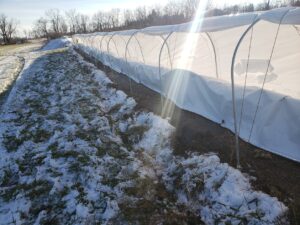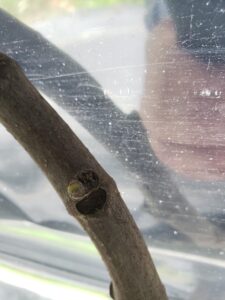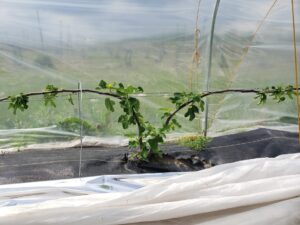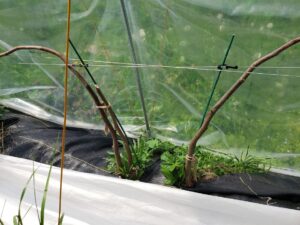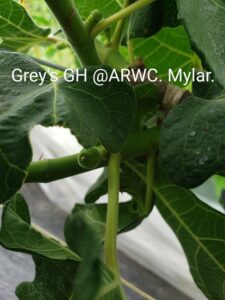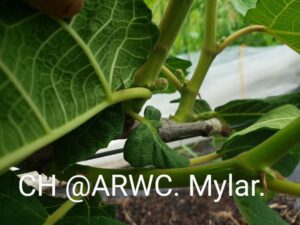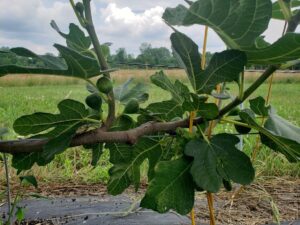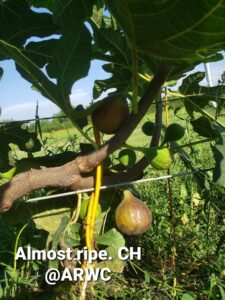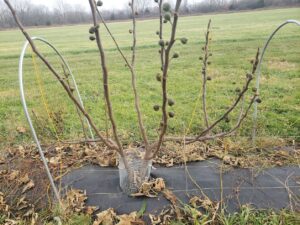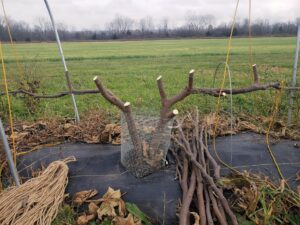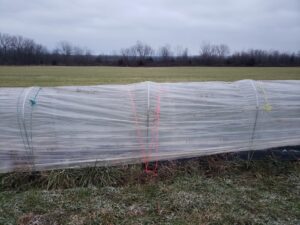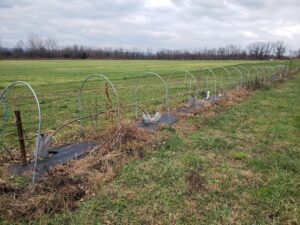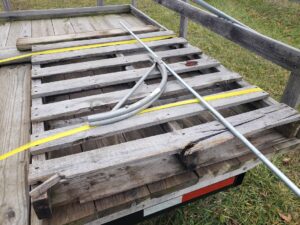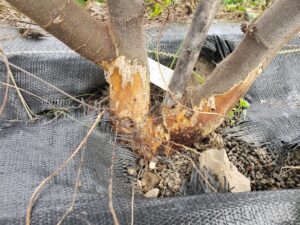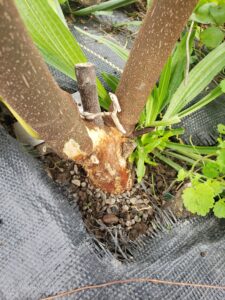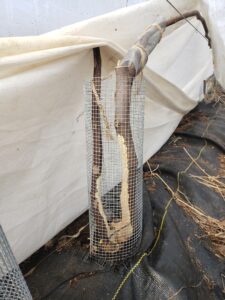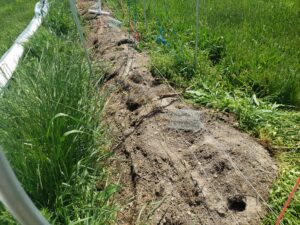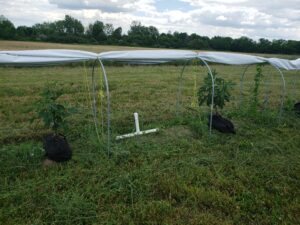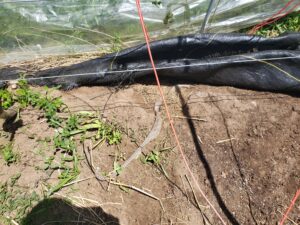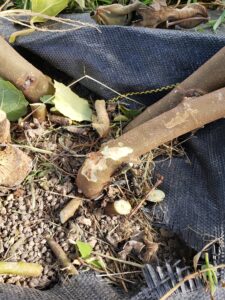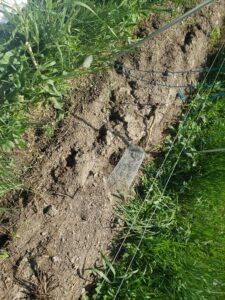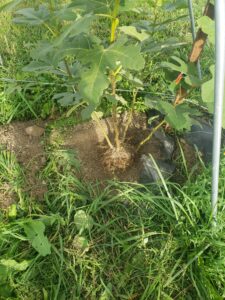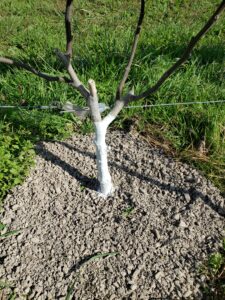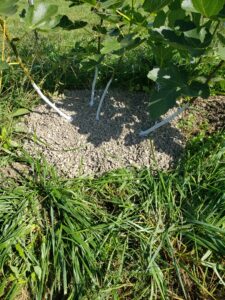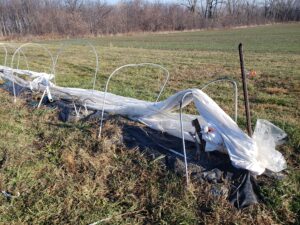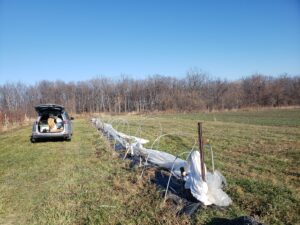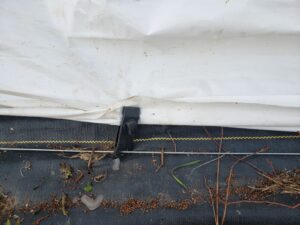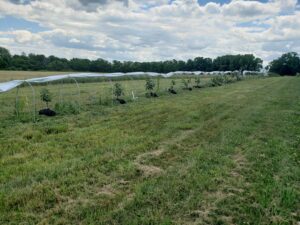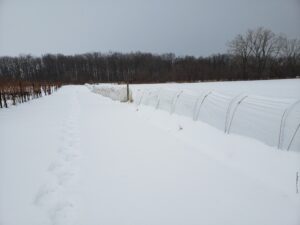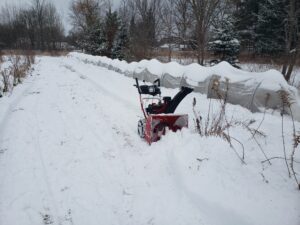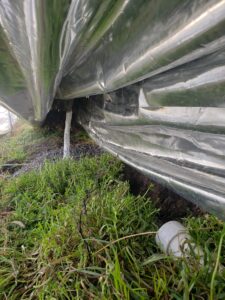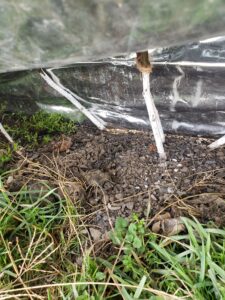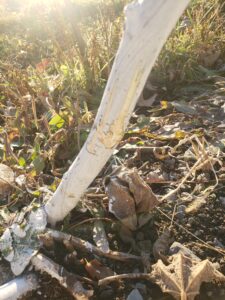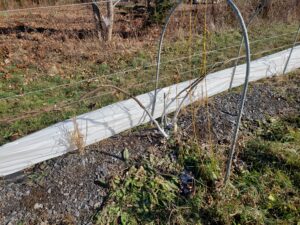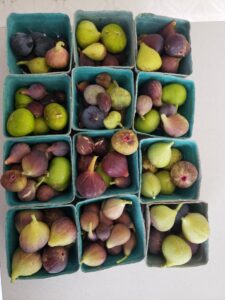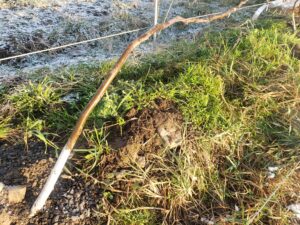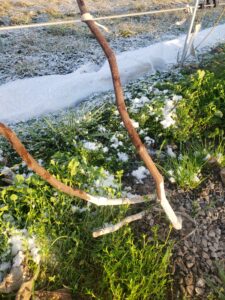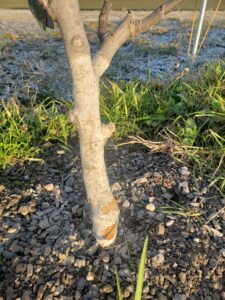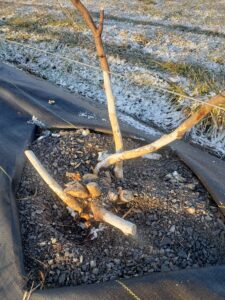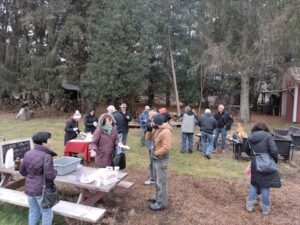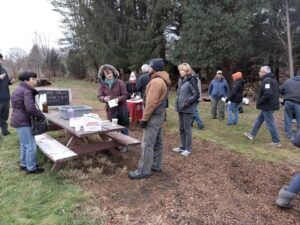Final report for FNE21-973
Project Information
This study sought to evaluate covering materials in a winter protection and phenological acceleration scheme involving low tunnels and fig trees. Layers of polyethylene plastic, commonly used on greenhouses, would be adapted for use as outer layers for low tunnels made by bending electrical conduit into hoops. Inner layers would be row cover or a mylar, reflective foil, material. Temperature sensors were placed to record ambient temperature, and the temperatures between the layers within the tunnels.
Unfortunately the covering materials proved inadequate in protecting the fig trees in two out of three of the years so phenological acceleration could not be evaluated. However, strong data was analyzed to suggest that mylar could be a particularly useful inner layer in a low tunnel protection scheme.
| Year | Location | Ambient Temp | Temp under Inner Protection | Delta ambient and inner temps | Protection Description |
| 2021 | Waterloo | -1.3 | 13.5 | 14.8 | CP6+CP4+RC |
| 2022 | Waterloo | -16.8 | 9.3 | 26.1 | CP6+WP4+RC |
| 2022 | ARWC | -8.5 | -1.3 | 7.2 | WP4+MY |
| 2023 | Waterloo | -6.3 | 7.8 | 14.1 | WP4+CP6+MY |
| 2023 | ARWC | -7.1 | -0.9 | 6.2 | WP4+MY |
CP6=6 mil clear poly. CP4=4 mil clear poly. WP4=4 mil white poly. RC=1.5oz row cover. MY=4 mil mylar.
Voles proved to be a significant, and undesired, component of the study. Voles caused arguably more damage than winter lows on the fig trees. Vole protection schemes were explored during this study and may prove invaluable to fig tree growers in the future. Mixing interior latex and castor oil was an effective deterrent against voles (but not rabbits), and surrounding the root ball with stones prevented voles from tunneling through the root structure (often fatal to trees). Zinc Phosphide was an effective component in this protection strategy as well.
In the fall of 2022 I hosted a fig open house at which around 25 curious growers, and my local cooperative extension branch, explored the fig operation and got to learn from all my mistakes. I've also had correspondence from many other fig growers around the country, and have shared my results in fruit growing forums for all to enjoy.
This project seeks to find a combination of protection materials in a low tunnel system that will allow figs to both survive winters in the northeast, and accelerate the ripening of figs for increased production.
- Winter fig survival through protection materials in low tunnel system.
- Temperature data: Within/without low tunnel. Inside 1st/2nd
- Phenology data: How many shoots emerged from the buds left after pruning and protecting over the winter.
- Accelerating fig ripening with the same materials used in low tunnel system.
- Temperature data: How much hotter/cooler depending on combination.
- Phenology data: When did bud break occur? When did the first fig form? When did the first fig ripen? How many figs per tree, per treatment?
- Pruning weights. Did the phenological boost result in increased growth?
If a combination of materials can be found that protects figs, and accelerates their ripening for increased productivity, farmers will have a system capable of being applied to other semi-hardy perennial crops. Figs, and many of these other crops, require few chemical inputs and outside of low tunnel setup, little labor.
Figs are a semi-hardy woody perennial that suffers significant damage when the temperature falls somewhere under 20 degree Fahrenheit. The second impediment to growing figs in the northeast is their need for a long season. While short season varieties exist that reliably ripen in zone 6, many of the longer season cultivars are regarded as superior. Figs also ripen sequentially, so the quicker the first fruit ripens, the longer the harvest season will be, and the more the trees will yield overall. Figs are a fruit high in nutritional value and require few, if any, chemical inputs to grow well. If a method reliably protecting, and accelerating their ripening, were developed, figs could go from a niche curiosity to a dependable niche tree fruit crop for small scale sustainably minded farms. Such a protection and ripening scheme could also then be applied to similar semi-hardy perennials such as pomegranates, pistachios, black mulberries, che, and loquats.
The creation of a farm scale protection and ripening scheme for figs would decrease my reliance on a high tunnel to protect the potted figs. In years past, this high tunnel was heated, representing a significant energy and economic sink. If the protection scheme were adopted by area farmers, they could potentially decrease their reliance on crop systems that are seeing increased pressure from herbicide resistant weeds, insecticide resistant pests, and fungicide resistant mildews. Less chemical inputs in the field mean less in our foods and drinking waters. To find a combination of protection and ripening materials I will use a low tunnel system. These systems are economical and have been shown to provide enough protection to reliably grow winter hardy vegetables. The study of the materials used for these systems has been limited, do not often use a second, interior hoop, and have rarely been studied with a woody perennial in mind. A combination of greenhouse poly plastic, row cover, and mylar film will be used in low tunnels with either a single or double hoop system. Temperature data will be recorded to differentiate the materials used in the low tunnel system, and the outside temperature. Phenology, including timing of bud break, number of shoots emerged versus buds left from pruning, first fig forming, first fig ripening, and total figs ripened by tree, will be recorded in the growing season. This will tell us how well the protection scheme worked, and if it accelerated phenology, ripening, and total yield.
Once the hoops are in place, and techniques related to the setup of the low tunnel system are learned, farmers will find that overall, labor costs are acceptable. Of the few successful fig farmers in the northeast, Threefold Farm, is able to sell their figs at $1 apiece (Clymer, 2018). Depending on the variety this could mean upwards of $10 per pound. Aside from the fig mite, native to areas of California and other Mediterranean climates, and rust, a fungus prevalent in very warm and wet areas like Florida, figs suffers from few pests. Some minimum of weeds control will be needed, but overall figs need few chemical inputs. Some back of the napkin economics suggest a 533% increase in fig fruit production if trees can emerge winter unscathed and ripen every fig they set (Caldwell, Google Sheet). This could mean $1872 difference per 12 tree row. Farmers may find that figs can be profitable, and very sustainable, if the proposed protection scheme is found successful and duplicable.
Annelise Farms received its nursery grower’s license in March of 2019. I grow figs, pomegranate, and mulberries from cuttings that I then sell as plants to the public through word of mouth and at local farmers markets. I’ve expanded into limited sales of fresh figs to local restaurants, and bakeries. This summer I rented a several fig trees for ambiance and seating demarcation in a restaurant parking lot. I use space in a hoophouse for the cuttings and potted fig trees, otherwise the three (soon to be four) fig tunnels at two locations are my operation.
Cooperators
- - Technical Advisor
Research
Research Plan:
Low tunnels will be setup on rented land at two locations: Lake Drum Orchard, 79 Stark Street, Waterloo, NY, and Anthony Road Wine Company, 1020 Anthony Road, Penn Yan.
The low tunnel setup will consist of 10’ long electrical conduit pipes bent to make hoops that are three feet wide, and about 42” tall. The trees will be spaced eight feet apart, in a 100 foot long row (so 12 trees per row). There will be three tunnel rows at one location (site A), and one tunnel row at a second location (site B). All four tunnels will have interior hoops made from 9 gauge soft vineyard wire that are four feet in circumference (one foot wide). All four tunnels will be covered with 6 millimeter thick greenhouse plastic on the exterior hoops. The interior hoops will be covered with different material combinations that will serve as the treatments for the study. As seen in Table 1, tunnel 3 will serve as the control. In the spring, when the threat of sub 20F temperatures abates, all materials will be removed from tunnel 3. Tunnels 1, 2, and 4 will serve as the separate treatments and will keep their materials in place until growth begins to touch the material. So first the interior material will be removed, then the exterior as growth continues.
Table 1: Tunnel Treatments and Locations
|
Tunnel Name |
Exterior Material |
Interior Material |
Location |
SOP |
|
Tunnel 1 |
6 mil poly |
1.5oz row cover |
Site A |
Leave materials until growth touches top. |
|
Tunnel 2 |
6 mil poly |
6 mil mylar |
Site A |
Leave materials until growth touches top. |
|
Tunnel 3 |
6 mil poly |
2.5mil overwintering poly |
Site A |
Control. Remove materials after threat of sub 20F temperatures abates. |
|
Tunnel 4 |
6 mil poly |
1.5 row cover/2.5 mil overwinter poly |
Site B |
Leave materials until growth touches top. |
All figs will be trained in a cordon-cane or cordon-spur manner. This requires, and allows, pruning and tying in the fall to fit under the protection scheme of hoops and plastic. Being low and fairly wide creates a large ground footprint under protection. The theory is that ground heat, and not the R-value of the protection materials, is the most important factor in moderating temperature extremes. My familiarity with cordon pruning and growing systems through grapevine production will make phenological tracking easy and reliable.
Three out of four of these tunnels are already planted with fig trees. Six trees were planted in 2018, the other 30 were planted in 2019. This will allow data to be collected regarding fruit production immediately, as 36 out of 48 total trees will be of mature bearing age. Twelve trees will be planted in spring 2021, using the same spacing and will be protected, grown, and trained in the same manner as the older trees. I hope to plant six of the trees to the same variety, and the other six to either another variety or at least the same family. The one downside of the existing plantings is that variety is scattershot. The new planting will help to cut down on some noise. That being said, this study is focused on temperature protection and phenological acceleration regardless of variety.
The temperature probes used for this proposal are made by Ambient Weather/Ecowitt and connect with a sensor hub/monitor via radio wave. The sensor hub/monitor connects to the internet via Wi-Fi and results are available, and recorded, by the minute. There is no local backup of data in the event of Wi-Fi failure. This is potentially problematic but keeps the cost of the project down. Temperature probes will be placed outside of the tunnels, within the tunnel between the interior and exterior hoops, and within the interior hoop if that hoop exists. I will attempt to protect the probes from solar radiation throwing off the temperature during the day by shielding them. The recorded temperature data will be analyzed, comparing lowest, highest, and average temperature experienced. This data can be used to make a growing degree days chart for each treatment, showing the presumed acceleration of ripening through materials used. These probes also measure humidity, so dew point can be calculated. The temperature data from the probe placed outside the tunnels will be corroborated by the closest available weather station.
The material coverings will be applied in the fall when the forecast shows consistent sub-freezing temperatures, or a low under 25F. My guess is early December. The materials will be removed in the spring, from the interior materials to the exterior materials, as the shoots of the tree threaten to touch each layer. If temperatures reach over 95F in the spring, the tunnels will need to be vented by pulling up the plastic on the sides.
Phenology will be recorded first by counting the number of buds left post-pruning and tying to the low cordon system. My goal is 12-15 viable shoots per mature tree. I may leave slightly more, anticipating some damage, then prune those away in the spring with bud emergence. The buds that emerge as viable shoots during bud break will be counted to see how well the protection worked. Any frost damage incurred from advancing bud break through the protection materials will be noted. The date of bud break will be recorded for each tree, in each treatment as well. Next, when figs first form by tree will be recorded. After that, the date on which the first ripe fig is picked will be recorded. Each tree will be tracked by harvest to show total figs per tree over the course of the season. A five to ten fig sample of each variety will be used to find average fig weight so yield weight can be estimated. Pruning weights will be taken in November, before installing the protection materials, to see if the (presumed) phenological boost affected the total growth of each tree. Any unanticipated results that may have a relationship to the protection scheme will be recorded.
Research progress 2021-2022
While my project didn't receive funding until the end of March of 2021 I did have aspects of the project proposal in place prior to funding so I will briefly discuss the results of my protection schemes from winter 2020-2021 as they have bearing on my phenological recording during the growing season of 2021; they also informed my protection scheme for this winter (2021-2022).
Protection 2020-2021
@Site A (Waterloo, NY), 1 tunnel (12 trees)
Clear Poly (6mil) + Clear Poly (4mil) + Row Cover (1.5oz)
@Site B (Dresden, NY), 2 tunnels (24 trees)
North Tunnel- Clear Poly (6 mil) + Clear Poly (4mil)
South Tunnel- Clear Poly (6 mil) + Mylar (2 mil)
The site A tunnel was partially protected on 12/11/20 (outside, clear poly layer only). Site B tunnels were fully covered on 12/23/20 while the site A tunnel was fully covered on 12/24/20.
Phenology 2021 Growing Season
Budswell was observed towards the end of March and by 4/9/21 a few buds close to the ground had just opened. Despite these early signs, and congruent with the cool April of 2021, the trees really didn’t experience budbreak till close to 5/1/21. And even then they didn’t pick up much steam until about the second week of May. This can be attributed to possible vascular damage from impaired cold hardiness, as well as the cool spring temperatures.
The first fig primordia (bumps before figs emerge from shoot) were observed on 5/31/21 on the early varieties (mostly Mt Etnas like Chicago Hardy). At 6/15/21 the early varieties were at pea size while fig primordial bumps were observed on the later varieties like Galbun, Gros Monstrueuse and Lebanese Red. By 6/29/21 the early varieties were at cherry size, which is very close to lag phase, while the late varieties were at pea size. By 7/9/21 most later varieties had reached cherry size.
On 8/30/21 the first color change was observed on a Chicago Hardy tree at Site B. Color change was then seen on a somewhat later variety (Giant Amber) on 9/5/21 at Site A. Sometime between 8/30/21 and 9/5/21 the first ripe figs were enjoyed by a non-human. As a reference point, the first ripe figs from potted fig trees not associated with this project were enjoyed on 8/7/21. On 9/20/21 the first VdB showed color change. On 10/10/21 the first Galbun was ready for harvest. On 10/15/21 the first AJH ripened (tied with VdB for last to ripen in most years).
Ideal Tree Case Study 2021
At Site B one tree, a Graye’s Greenhouse (heirloom fig from Mt Etna family), came through the winter with little damage. This tree was observed as an ideal case study on 9/28/21. It had two trunks and one retained sucker to be used as a possible renewal trunk. There were four shoots on one trunk, and seven on the other. From the shoots, including the renewal, 181 figs were counted as being at cherry size or larger. I’m using cherry size as a proxy for the figs being at lag phase. I think 20 figs were already picked by this time, meaning this tree set 201 figs total.
On 11/04/21 this tree was observed as having 83 figs at cherry size left unripened. It stands to reason that between 9/28/21 and 11/04/21 close to 100 figs were picked off this tree.
The full data can be viewed here- https://docs.google.com/spreadsheets/d/1nK3NRFfyOtA3xm4PgP4MBeMI02oc4LrG8mnQXYlbkfY/edit?usp=sharing
Harvest Notes 2021
Around 40-50 figs were left unripened on Gros Monstrueuse. Around 40 ripe figs were picked off four VdB trees. These trees did not benefit from a head start (phenological acceleration) in the spring from the protection materials, in fact they suffered due to the protection materials due to compromised cold hardiness, and struggled to ripen figs in the limited zone 6a season. For anyone planting I’d concentrate on planting early varieties unless the late varieties pull a premium to make up for lack of production. I hope that I’ll see better results (i.e. accelerated growth) this spring with better protection materials.
Pruning Weights 2021
I don’t think too much can be gleaned from this data except that trees that survived the winter better produced more wood in the growing season. The ideal case study tree, Graye’s Greenhouse, grew 5.75 pounds of wood in the 2021 growing season. The average for the site B south tunnel (without Graye’s) was 1.6 pounds, while the north tunnel was 1.48 pounds. The trees at colder Site A, having taken more damage, produced an average of 1.09 pounds per tree.
Full data available here- https://docs.google.com/spreadsheets/d/1nK3NRFfyOtA3xm4PgP4MBeMI02oc4LrG8mnQXYlbkfY/edit?usp=sharing
Tunnel Construction 2021
A new fig tunnel, site B middle, was planted around 6/1/21. It has six trees of one variety, and six that are from the same family (Mt Etna). This uniformity should lend itself to data comparison. All 12 of these trees are early ripening, which should help production. The construction of this tunnel was slightly different than the previous three. Rebar stakes were driven into the ground, and the EMT hoops were placed onto the rebar. The rebar and EMT were joined by EMT couplers. Unlike previous tunnels, the landscape fabric was laid down prior to planting in the spring (much easier than retrofitting). This tunnel, Site B north, and the tunnel at Site A, use a draping wire for the inner protection layer. Site B South uses small hoops made from nine gauge vineyard wire. All tunnels now have a “purlin” wire that runs through the EMT hoop at its apex and is secured to the end posts. This prevents the hoops from wiggling free from where they’re attached to their stakes.
Unfortunately, lack luster planning and a late grape harvest season pushed back the completion of this tunnel until 12/27/21. Protection was put into place at all tunnels by 12/27/21, but was not fully buttoned up until 1/7/22. Supply chain issues delayed the placement and activation of temperature sensors until 1/8/22 at Site A and 1/15/22 at Site B.
Protection 2021-2022
Site A- Clear Poly (6 mil) + Row Cover (1.5oz)
Site B, South- White Poly (4 mil) + Mylar (7 mil)
Site B, Middle- Clear Poly (6 mil) + Mylar (7 mil)
Site B, North- White Poly (4 mil) + Clear Poly (4 mil)
This setup will allow us to decouple the influence of the white poly, outer, and mylar, inner, layers. Unlike the mylar from the 2020-2021 season, this mylar is white on one side. The reflective side was faced inward, to retain the ground heat. We’ll see how the white outside layer does in reducing heat spikes from the winter sun.
2022-2023 Disasters and Pivoting
During the winter of 2021-2022 voles damaged or destroyed 90% of the fig trees overall, and 100% at the Dresden location. Around 1/3 of the trees in Dresden were not salvageable and had to be replaced in the spring of 2022. The remaining 2/3rds were set back to the soil line due to girdling. Some trunks may have suffered winter damage in addition but it was difficult to decouple the two effects. My best guess is that the cozy conditions of the low tunnels caused first a slow build up (the first few winters) then an explosion of the vole population (2021-2022 winter). The sheer numbers of the voles prevented their control by poison alone, and encouraged feeding on the fig trunks due to competition and food scarcity.
Some relevant data was collected by the temperature sensors which will be discussed in the results section, but from a farming perspective the voles effectively killed any hopes for growing season research--recording pruning weights, phenology dates, or crop weights and counts. With this in mind I pivoted this project to paying more attention to vole protection, and a discussion of what went wrong.
Landscape Fabric
After the full scope of the destruction caused by the voles became apparent in the spring my first move was to remove the landscape fabric. My original idea forthe fabric was to warm up the soil, accelerating phenology, and keep the weeds at bay since as a side project I'm not always able to devote as much time to the figs as I'd like. Unfortunately, it proved an ideal habitat for the voles. Upon removal I found extensive tunneling, often leading up to, under, and through the roots of the fig trees. I left landscape fabric on one fig tunnel row (out of the four total) as a "high pressure control" of sorts, to see if my other vole damage prevention measures are enough on their own. In the 2022 growing season weeds were controlled with a combination of weed whacking and contact (non systemic) herbicides. The landscape fabric did seem to encourage a strong native snake population, but unfortunately they aren't active during the winter when we need their help.
Vole Protection 2022 Edition
Previously my vole protection consisted of PVC bait stations filled with zinc phosphide bait, generally two per 100 foot tunnel, and hardware cloth around at least 50% of the trunks for each tree. After watching the voles dig under the hardware cloth, first eating through the roots and then emerging to girdle the trunk, I decided to ditch this method entirely. I do think it could be effective if you are able to place the hardware cloth deep enough at the same time as planting the tree--but it would need to be wide enough to accommodate future growth. In the late summer of 2022 I started overhauling the vole protection program by first digging around the root ball of each tree. I removed as much dirt as I could then back filled with no.2 stone. The idea being that the voles would be discouraged by trying to dig through the stones and find easier meals. That left above ground protection, which I attempted to solve by painting the trunks with a paint and castor oil mix. I used interior latex as it's supposed to be both persistent and permeable. Castor oil is supposed to be a strong rodent repellent. I did not dilute the paint and the ratio was something like 5:1 paint to oil (this is significantly more oil than recommended but their use cases weren't with paint). A few extra trunks were left unpainted as a poor man's control for this experiment. And again one tunnel at the Dresden location still has landscape fabric so it's the "high pressure control" of sorts. The bait stations will be refilled more aggressively over the winter of 2022-2023 than they've been in the past.
2022 Changes to Low Tunnels
A few changes were made to the low tunnels at both locations in preparation for the 2022-2023 winter. The clear poly used for the 2021-2022 winter at Dresden was 2 mil overwintering clear plastic instead of the intended 6 mil clear plastic. This was a bone headed mistake and will be discussed further in the discussion section. So this winter the correct 6 mil clear poly is in place. No row cover will be used this year at the Waterloo tunnel location. Instead, a double outer layer (white 2 mil overwintering plastic, then 6 mil clear poly inside) is in place, with an inner layer of mylar.
At the Dresden location the north most tunnel suffered extensive wind damage in the fall when covering materials were left attached to the ends but not secured to the individual hoops. In response, I took down all the hoops and am instead calling the north tunnel the low-low tunnel as it's a 20 inch tall triangle shape (the regular hoop tunnels are 42" tall). This tunnel has two layers: white 2 mil overwintering plastic, then 6 mil clear poly. Both layers have been doubled up by folding them over top of themselves, and secured using tarp clamps and vineyard wire. If temperature data shows this method to be beneficial it's an attractive and simple alternative to the EMT hoops which require several onerous steps before and during setup.
Misc Notes: Irrigation stakes (1/2") are a cheap and useful option for anchoring the plastic to the ground, especially next to where the rope tie downs are secured as that creates a natural gap. The tunnel ends have always been tricky to secure and I've found spring clamps to be simple and effective. In the summer of 2022 I left some of the covering materials in the field by securing them to the purlin wire that connects the EMT hoops. They didn't suffer any significant damage though they would sometimes fill with rain water (I found tying them tight together to the wire at least once between the hoops to help cut down on this). It did make the fall covering easier, though it likely shortens the lifespan of the covering materials.
Results & Discussion 2021
Temperature data is only available for site A. The lowest recorded temperature that the fig trees experienced under the inner layer of protection was 13.5F on 1/30/21 when the outside ambient temperature hit -1.3F. On 12/18/20 the trees experienced 15.3F while outside it was 3.6F. I mention that because the trees only had one layer of protection and in mid-December they may not have been at peak cold hardiness.
Snow cover heavily influenced the level of protection. For example, on 2/20/21 site A received around eight inches of snow. On 2/21/21 the outside temperature dropped to 0.7F while under the inner protection the figs enjoyed a balmy 30F. When time permitted I tried to bolster this affect by mounding snow onto the tunnel using a snowblower. In contrast, on 1/9/21 with no snow cover the difference between outside (15.4F) and the inner layer (18.9F) was only 3.5 degrees.
The full data set and charts can be accessed here-- https://docs.google.com/spreadsheets/d/1DZWZkTFkATfm0AITchveZ5xHrkKgEyjMJv-Ui5WZIOI/edit?usp=sharing
For protection from deep winter lows the protection scheme of layers of clear poly worked very well. Fig trees should be able to survive 13.5F with low/acceptable levels of damage that can be worked around by leaving extra buds and canes. Unfortunately the clear poly also resulted in sharp spikes in temperature on sunny winter days that very likely disrupted the cold hardiness of the fig trees and may have also resulted in some trunk cracking. For example, on five separate days in January the innermost layer of protection recorded higher than 90F. In the spring, most trees showed heavy signs of damage. Most died to their trunks (around 12 inches off the ground), while some died to the ground. No trees died outright. The only exceptions were the trees on the outside of the tunnels, which may have resulted from air infiltration due to poor sealing. The trees at Site B with the mylar inner protection layer fared better than the other tunnels as well. I suspect the reflective properties of the mylar mitigated the heat spikes while also reflecting ground heat.
These results motivated the PI to change the materials used for the winter of 2021-2022 to include white poly to decrease the chances of temperature spikes on sunny winter days.
Initial Results, Winter 2021-2022
As noted above data collection for winter temperature readings did not commence until 1/8/22 at Site A and 1/15/22 at Site B. Initial low temperature recordings at Site A are discouraging.
1/11/22, 3am. Outside Temp: 7.0F. Outer Layer: 8.0F. Inner Layer: 12.4F
1/15/22, 3am. Outside Temp: 0.7F. Outer Layer: 5.3F. Inner Layer: 8.5F
1/15/22, 11pm. Outside Temp: -2.1F. Outer Layer: 0.3F. Inner Layer: 5.3F.
So the fig trees at Site A have already experienced a much lower temperature (5.3F) than they did in the winter of 2020-2021 (13.F). Also problematically, the trees have experienced temperatures over 67F on four days already (though only one day over 80F).
From just two days of real data from Site B no interpretations should be ventured. But venture I shall. The daytime data is encouraging. The outer white poly stayed 3-6 degrees cooler than the clear poly outer layer. The mylar inner layers actually read cooler than the outer (between layers) probes, suggesting the mylar material was actually reflecting the coolness of the partially frozen ground. Unfortunately the inner layers recorded abysmal temperatures on the morning of 1/16/22. The south tunnel read 0.9F, the middle -1.8F, and the north 3.6F. If these were true readings it would be likely that all trees will be reset to the ground. I’m holding out hope it was some kind of fluke due to radiative cooling or the sensors hadn’t grown their winter skin yet.
Photos available here-- https://photos.app.goo.gl/ChgKbTAYxUdAEays9
2021-2022 Winter Results and Discussion
Sensor Issues
For this study I used a combination of Ambient Weather and Ecowitt wifi gateways and sensors (they appear to be the same hardware). The gateway unit needs a wifi connection to log the data and the sensors need to be within radio range (around 300 feet). The benefit to using this setup is that it is very inexpensive, can be monitored on the fly, saves to the cloud, and can be setup with temperature alerts (helpful for say greenhouse growers who can turn on a heater, aka do something other than chew on their nails). I ran into several of the drawbacks, however. For one, both of my growing locations were farther than 300 feet. At the Dresden location this meant that the closest tunnel uploaded data the most consistently and the farthest was the least reliable. Using lithium AA was a big help but at low temperature the sensors could become less reliable (just when you want them to be the most reliable).
Using mylar as one of my covering materials caused interference rendering the normal sensors useless. The work around is to use sensors that have a wired probe so you can put the sensor body outside of the mylar but have the probe measure the temperature under the covering. This works great until rodents start chewing on the wires. This happened multiple times over the course of the winter.
Alternatives to these sensors seem to be coming into more widespread use. SensorPush makes a bluetooth connectable sensor that uploads its data once you come within bluetooth range. At the moment they're too expensive for widespread use ($90/piece, the Ambient/Ecowitt sensors are $15-20/piece), but the price may fall.
Cold Temperatures and Low Tunnel Materials
The right combination of materials for protection of fig trees (or any sensitive plants) from winter low temperatures remains elusive but mylar is cementing itself as part of the solution. Greenhouse plastic, whether 6 mil poly or 2 mil white overwintering poly, has performed in an underwhelming fashion and the temperature sensors have even reported figures below ambient temperature perhaps due to radiative cooling (where IR waves escape at a disproportionate rate due to the transparency of the plastic). Whereas clear 6 mil or 2 white 2 mil poly had a minor effect on temperature (between -2.2 and +2.6F difference), mylar had a consistently positive effect generally adding 6-7 degrees over ambient temperatures in four different cold episodes between 1/22/22 and 3/4/22. Sensor malfunctions prevented data from all materials being compared in some cases but in all cases some contrast was evident between the temperature under the mylar and outside of the mylar.
WP=white poly. MY=Mylar. CP=Clear Poly.
| Location | Date | Tunnel | Material | Temp (F) | Diff from Amb |
Diff from Outer Material
|
| ARWC | 1/22/2022 | South | WP | -8.00 | 0.50 | |
| ARWC | 1/22/2022 | South | WP+MY | -1.30 | 7.20 | 6.70 |
| ARWC | 1/22/2022 | Mid | CP | -10.70 | -2.20 | |
| ARWC | 1/22/2022 | Mid | CP+MY | -2.40 | 6.10 | 8.30 |
| ARWC | 1/22/2022 | North | WP | -4.60 | 3.90 | |
| ARWC | 1/22/2022 | North | WP+CP | -4.00 | 4.50 | 0.60 |
| ARWC | 1/22/2022 | Ambient | Ambient | -8.50 |
| Location | Date | Tunnel | Material | Temp (F) | Diff from Amb |
Diff from Outer Material
|
| ARWC | 2/5/2022 | South | WP | 4.80 | 2.20 | |
| ARWC | 2/5/2022 | South | WP+MY | 9.50 | 6.90 | 4.70 |
| ARWC | 2/5/2022 | Mid | CP | 5.20 | 2.60 | |
| ARWC | 2/5/2022 | Mid | CP+MY | 9.50 | 6.90 | 4.30 |
| ARWC | 2/5/2022 | North | WP | 5.70 | 3.10 | |
| ARWC | 2/5/2022 | North | WP+CP | |||
| ARWC | 2/5/2022 | Ambient | Ambient | -2.60 |
| Location | Date | Tunnel | Material | Temp (F) | Diff from Amb |
Diff from Outer Material
|
| ARWC | 2/14/2022 | South | WP | 0.90 | -1.80 | |
| ARWC | 2/14/2022 | South | WP+MY | 6.60 | 3.90 | 5.70 |
| ARWC | 2/14/2022 | Mid | CP | -1.80 | -0.90 | |
| ARWC | 2/14/2022 | Mid | CP+MY | 0.70 | -2.00 | -1.10 |
| ARWC | 2/14/2022 | North | WP | -2.20 | -0.50 | |
| ARWC | 2/14/2022 | North | WP+CP | |||
| ARWC | 2/14/2022 | Ambient | Ambient | 2.70 |
| Location | Date | Tunnel | Material | Temp (F) | Diff from Amb |
Diff from Outer Material
|
| ARWC | 3/4/2022 | South | WP | 7.20 | 0.00 | |
| ARWC | 3/4/2022 | South | WP+MY | 11.80 | 4.60 | 4.60 |
| ARWC | 3/4/2022 | Mid | CP | 1.60 | -5.60 | |
| ARWC | 3/4/2022 | Mid | CP+MY | 9.90 | 2.70 | 8.30 |
| ARWC | 3/4/2022 | North | WP | 3.70 | -3.50 | |
| ARWC | 3/4/2022 | North | WP+CP | |||
| ARWC | 3/4/2022 | Ambient | Ambient | 7.20 |
The other consistently positive covering material in this study has been snow. At site B (in Waterloo, NY) I was able to use a snowblower to cover or seal the edges of the low tunnels when snow was available. The results stand out as outliers when looking through the data. Similar cold temperatures were experienced on 1/26/22 and 2/5/22 but the results are markedly different due to the influence of snow cover. Seen below, it looks like even partial insulation by snow could be responsible for as much as a 14 degree increase.
RC=Row Cover
| Location | Date | Tunnel | Material | Temp (F) | Diff from Amb |
Diff from Outer Material
|
| Waterloo | 1/26/2022 | Back | CP | 2.7 | 11.4 | |
| 1/26/2022 | Back | CP+(WP+RC) | 11.1 | 19.8 | 8.4 | |
| 1/26/2022 | Ambient | Ambient | -8.7 |
| Location | Date | Tunnel | Material | Temp (F) | Diff from Amb |
Diff from Outer Material
|
| Waterloo | 2/5/2022 | Back | CP | 16.2 | 25 | |
| 2/5/2022 | Back | CP+(WP+RC) | 19.8 | 28.6 | 3.6 | |
| 2/5/2022 | Ambient | Ambient | -8.8 |
This effect of snow can also be seen when contrasting the effects of covering materials at the two different sites. Between 2/14/22 and 2/15/22 Dresden experienced a low of 2.7F while Waterloo experienced -1.0F. The cumulative covering materials in Waterloo bumped the temperature up 12.7F, while in Dresden similar materials only boosted the temperature 3.9F--the sole difference being the level of snow built up around each tunnel.
| Location | Date | Tunnel | Material | Temp (F) | Diff from Amb |
Diff from Outer Material
|
| Waterloo | 2/15/2022 | Back | CP | 5.4 | 6.4 | |
| 2/15/2022 | Back | CP+(WP+RC) | 11.7 | 12.7 | 6.3 | |
| 2/15/2022 | Ambient | Ambient | -1 |
Overall, while it seems like mylar is part of the solution further research into better insulating materials is needed. Vegetable farmers often use a heavy felt material to cover their fragile greens in the spring, these kind of textiles could work well in tandem with an outside layer of plastic to keep them dry and hoops or a draping wire to support their weight. Organic materials like composting leaves could also play some role, particularly in sealing the edges of the tunnels.
Hot Temperatures and Low Tunnel Materials
While not as obvious as the damage caused by voles and cold temperatures, damage to fig trees caused by heat should be a strong consideration for materials selection in a low tunnel system. The temperature spikes caused by a greenhouse effect with clear poly can wreck havoc on the cold hardiness of perennials and can also throw off your data analysis. On average, the covering materials for the Waterloo fig tunnel increased the temperature roughly between 7 and 10 degrees over ambient in January 2022. That sounds great. Except that much of that temperature boost may come from the afternoon sun, wasted heat that is possibly detrimental to the cold hardiness of the trees.
| Location | Month | Tunnel | Material | Avg Temp | Avg High Temp | Avg Diff from Amb | Avg H Diff from Amb |
| Waterloo | Jan | Back | CP | 25.51 | 33.44 | 6.91 | 10.99 |
| Waterloo | Jan | Back | CP+(WP+RC) | 28.58 | 36.12 | 9.98 | 13.67 |
| Waterloo | Jan | Ambient | Ambient | 18.6 | 22.45 | 0 | 0 |
Another way to quantify this is to count the number of times the temperatures under the covers exceeded 60F. While this could be beneficial to getting off to a strong start later in the spring, in the winter it may pull the trees out of dormancy right in time for a killing cold snap. Below is a count (each count represents a four hour increment) of the times the temperature exceeded 60F between January and March.
| 4 HR Increments | |||||
| Location | Month | Tunnel | Material | CT: Times above 60F Avg Temp |
CT: Times above 60F Avg H Temp
|
| ARWC | Jan | South | WP | 0 | 0 |
| ARWC | Jan | South | WP+MY | 0 | 0 |
| ARWC | Jan | Mid | CP | 1 | 3 |
| ARWC | Jan | Mid | CP+MY | 0 | 0 |
| ARWC | Jan | North | WP | 0 | 0 |
| ARWC | Jan | North | WP+CP | 1 | 1 |
| ARWC | Jan | Ambient | Ambient | 0 | 0 |
| 4 HR Increments | |||||
| Location | Month | Tunnel | Material | CT: Times above 60F Avg Temp |
CT: Times above 60F Avg H Temp
|
| ARWC | Feb | South | WP | 2 | 18 |
| ARWC | Feb | South | WP+MY | 0 | 2 |
| ARWC | Feb | Mid | CP | 8 | 29 |
| ARWC | Feb | Mid | CP+MY | 3 | 9 |
| ARWC | Feb | North | WP | 3 | 15 |
| ARWC | Feb | North | WP+CP | - | - |
| ARWC | Feb | Ambient | Ambient | 0 | 5 |
| 4 HR Increments | |||||
| Location | Month | Tunnel | Material | CT: Times above 60F Avg Temp |
CT: Times above 60F Avg H Temp
|
| ARWC | March | South | WP | 32 | 61 |
| ARWC | March | South | WP+MY | 15 | 34 |
| ARWC | March | Mid | CP | 35 | 64 |
| ARWC | March | Mid | CP+MY | - | - |
| ARWC | March | North | WP | 29 | 52 |
| ARWC | March | North | WP+CP | 26 | 40 |
| ARWC | March | Ambient | Ambient | 11 | 20 |
| 4 HR Increments | |||||
| Location | Month | Tunnel | Material | CT: Times above 60F Avg Temp |
CT: Times above 60F Avg H Temp
|
| Waterloo | Jan | Back | CP | 2 | 11 |
| Waterloo | Jan | Back | CP+(WP+RC) | 2 | 18 |
| Waterloo | Jan | Ambient | Ambient | 0 | 0 |
| 4 HR Increments | |||||
| Location | Month | Tunnel | Material | CT: Times above 60F Avg Temp |
CT: Times above 60F Avg H Temp
|
| Waterloo | Feb | Back | CP | 8 | 32 |
| Waterloo | Feb | Back | CP+(WP+RC) | 12 | 30 |
| Waterloo | Feb | Ambient | Ambient | 1 | 1 |
| 4 HR Increments | |||||
| Location | Month | Tunnel | Material | CT: Times above 60F Avg Temp |
CT: Times above 60F Avg H Temp
|
| Waterloo | March | Back | CP | 34 | 62 |
| Waterloo | March | Back | CP+(WP+RC) | 39 | 66 |
| Waterloo | March | Ambient | Ambient | 9 | 20 |
Gleaning through this data, it's immediately evident how detrimental clear poly can be while mylar has a strong mitigating effect on temperature spikes. It's also readily apparent how the sun picks up steam in the second half of February and has a very strong effect in March. Growers should consider venting their tunnels on sunny days late in February and certainly in March. There may be a point in March in which killing winter temperatures for figs is passed (mid-March), in which case removing the materials altogether is an option. This would prevent early wake up (when desired) and any preserve any remaining cold hardiness.
There is a material used in greenhouses that consists of alternating strips of clear poly and foil to retain heat. For a low tunnel it could also be used to reflect away excess sunlight. Another option is to spray on an overwintering paint, another technique used by some greenhouse growers. The overwintering white poly had a lesser effect than expected so outside of mylar the search continues.
Vole Protection Revisited
While we're only a few months into the winter of 2022-2023 the results of our redesigned vole protection have been encouraging. First, it's important to note that rabbits and voles are not the same (:P). Rabbits have continued to do damage to the fig trunks regardless of whether they were painted or not. While rabbits do not seem to dig under the tunnel materials, and thus are excluded by them, they often do their damage in the fall before the covers are applied. The good news is that the stones seem to be discouraging the voles from digging around the root mass and the paint is repelling them from eating the trunks. WOOOOO. There is evidence of vole tunneling, especially around the bait traps, suggesting they are taking the bait. Several vole corpses have been discovered too, RIP. All that said I haven't had a chance to check the high pressure tunnel (landscape fabric remains), and there are plenty of months to go. It also looks like the paint is starting to degrade and there is evidence of the voles nibbling on trunks that did not get painted. We shall see. The first picture is of a shallow vole hole in the no 2 stone.
The Fig Market
While the in ground fig trees that are the subject of this study contributed very little to fig sales in the fall of 2022, the potted trees and in ground in the greenhouse trees had a banner year. Around 40 pints were sold through a winery tasting room, on display in a case next to cheese and white wine bottles. About 25 quarts were sold to a local restaurant who used them mainly for a fig, cheddar and bacon flatbread (yum). A couple bags of fig leaves and around 6 quarts were also sold to a winebar, which made a fig negroni by soaking the leaves in gin and using the fig fruit in a sweet vermouth. With the production potential of in ground figs, wholesale opportunities will have to be explored in the future. Collaborations with local breweries and wineries--maybe a Fig Field Day in the early fall--are another possibility. Fig cutting sales in the winter of 2022-2023 have been particularly strong and represent a nice no waste opportunity--and help spread the fig gospel to future growers.
Winter Results 2022-2023
Initial Snapshot, coldest temperature recorded:
| Ambient | WP+CP | WP+CP+Mylar | |||
| Waterloo | January | 14.7 | 19 | -- | |
| February | -6.3 | 3.6 | 7.8 | ||
| Ambient | S, WP | S, WP+M | Mid, CP | ||
| ARWC | January | 15.1 | 13.8 | 15.6 | 13.3 |
| February | -7.1 | -4.7 | -0.9 | -8.9 |
S=South tunnel
Mid=Middle tunnel
WP=White poly 3mil
CP=Clear poly 6mil
M or Mylar=4mil mylar
While there may have been marginally more snow at the Waterloo location than at the ARWC site, the only other difference between the two protection schemes would be the 6mil clear poly. Evaluating the trees in the spring, there was slightly better bud survival in Waterloo, supporting the survivability difference in temperatures between the two sites. Overall it seems mylar and clear poly have value while the thinner white poly may not be worth the effort. Decreasing the temperature swings inherent in using clear poly may be better accomplished using a white washing product (commonly used in some greenhouse setups).
Average temperatures, overheating:
The mylar layer is coated on both the inside and outside. Thanks to this dual layering it is effective both at reflecting ground heat to increase the lowest temperature experienced by the fig trees, and at reflecting the sun and decreasing the highest temperature the trees experience.
| Location | Month | Tunnel | Material | Avg Temp | Avg High Temp | Avg Diff from Amb | Avg H Diff from Amb |
| ARWC | Jan | South | WP | 34.18 | 38.08 | 0.92 | 2.85 |
| ARWC | Jan | South | WP+MY | 33.84 | 37.07 | 0.58 | 1.84 |
| ARWC | Jan | Mid | CP | 34.75 | 39.75 | 1.49 | 4.52 |
| ARWC | Jan | Ambient | Ambient | 33.26 | 35.23 | 0 | 0 |
| Location | Month | Tunnel | Material | Avg Temp | Avg High Temp | Avg Diff from Amb | Avg H Diff from Amb |
| ARWC | Feb | South | WP | 34.60 | 41.1 | 1.80 | 4.8 |
| ARWC | Feb | South | WP+MY | 33.1 | 38.6 | 0.3 | 2.3 |
| ARWC | Feb | Mid | CP | 35.9 | 44.1 | 3.1 | 7.8 |
| ARWC | Feb | Ambient | Ambient | 32.8 | 36.3 | 0 | 0 |
| Location | Month | Tunnel | Material | Avg Temp | Avg High Temp | Avg Diff from Amb | Avg H Diff from Amb |
| ARWC | March | South | WP | 38.3 | 43.8 | 2.1 | 4.3 |
| ARWC | March | South | WP+MY | 34 | 41 | -2.2 | 1.5 |
| ARWC | March | Mid | CP | 38.9 | 46.8 | 2.7 | 7.3 |
| ARWC | March | Ambient | Ambient | 36.2 | 39.5 | 0 | 0 |
A sharp increase in heating can be observed between January and February due to the longer day length and higher position of the sun in the sky. Around February 8th the amount of day light passes 10 hours for the day, this mark is used by vegetable growers to signify when many plants begin growing again after their winter dormancy.
| 4 HR Increments | |||||
| Location | Month | Tunnel | Material | CT: Times above 60F Avg Temp | CT: Times above 60F Avg H Temp |
| ARWC | Jan | South | WP | 0 | 7 |
| ARWC | Jan | South | WP+MY | 0 | 0 |
| ARWC | Jan | Mid | CP | 5 | 18 |
| Location | Month | Tunnel | Material | CT: Times above 60F Avg Temp | CT: Times above 60F Avg H Temp |
| ARWC | Feb | South | WP | 8 | 28 |
| ARWC | Feb | South | WP+MY | 2 | 6 |
| ARWC | Feb | Mid | CP | 13 | 37 |
| Location | Month | Tunnel | Material | CT: Times above 60F Avg Temp | CT: Times above 60F Avg H Temp | |
| ARWC | March | South | WP | 3 | 26 | |
| ARWC | March | South | WP+MY | 1 | 8 | |
| ARWC | March | Mid | CP | 6 | 29 |
First 18 days good data
|
Presented another way, the number of times the temperature went over 60F was reduced by the mylar material and generally increased as we approached spring. While the white poly didn't heat the tunnels as much as the clear poly did during the day, the reduction was slight and disappointing. The thinness of the white poly (4 mil vs 6 mil for clear) may explain some of this reduced effect. Alternative approaches or materials, like spraying on a temporary white coating onto the clear poly as some green houses do, a layer of shade cloth, or climate screens containing alternating strips of clear poly and reflective foil, are certainly worth exploring but were outside the parameters of this study.
Vole Protection Results
In the fall of 2022 a new vole protection scheme was enacted. This scheme included surrounding the root ball of the fig trees with number 2 stone by replacing dirt with stone, and painting the trunks with a mixture of interior latex and castor oil.
Overall, the results were promising if not perfect. Rabbits were completely undeterred by the trunk paint mixture and girdled several trees at the Waterloo location. If rabbit pressure is observed, tree guards are the only option. The landscape fabric was left on the north tunnel (12 trees) at the ARWC growing site as a high pressure experiment. Those trees experienced moderate vole feeding and a small amount of tunneling through the roots. On the other two tunnels (24 trees) where the landscape fabric was removed, there was only some slight feeding (no whole trunk girdling) on trunks where the paint had started to fade. While the paint held up fairly well, my recommendation would be to put the initial coat on during a dry spell in the fall then add a second coat just before putting the covering materials down.
Trunk painting looks to be a viable protection strategy against voles, not rabbits, in low to moderate pressure situations. In growing sites where the population has grown to large levels, trunk painting may not be enough. Note that the regular Zinc Phosphide in PVC bait trap program was still in place. It's also possible that removing the landscape fabric, which cannot be used when growing figs in ground, caused the vole populations to relocate from the south and middle tunnels to the north tunnel exacerbating the situation.
Low Low tunnel Failure
The north tunnel at the ARWC was also where we tried to tarp clips and vineyard wire alone, without EMT hoops, to make a low, low tunnel after the wind demolished the previous EMT setup. This did not work well. Without the rope ties across the "ribs" of the EMT hoop structure, or purlin wire through the center of the hoops, the wind was able to get under the plastic and compromise the tunnels. If a more comprehensive approach was taken, namely burying the edges of the plastic rather than relying on tarp clips and landscape staples, this low, low setup may have stood a better chance at success.
2021-2023 Low Tunnel Materials and Winter Temps Comparison
This study was focused on evaluating different materials for use in a winter protection scheme with low tunnels and fig trees. Ultimately all fruit trees and vines have a temperature below which their ability to fruit or survive will be compromised. In this study no fig trees died due to winter damage but a large majority could not set or ripen a crop due to winter damage. The temperature at which fig trees experience bud death isn't well agreed upon but seems to be somewhere between 5F under ideal winter conditions with cold hardy varieties, and 15-20F in winters with large temperature swings and not well suited varieties. So, let's use 10F as our marker at below which your fig crop is critically compromised.
| Year | Location | Ambient Temp | Temp under Inner Protection | Delta ambient and inner temps | Protection Description |
| 2021 | Waterloo | -1.3 | 13.5 | 14.8 | CP6+CP4+RC |
| 2022 | Waterloo | -16.8 | 9.3 | 26.1 | CP6+WP4+RC |
| 2022 | ARWC | -8.5 | -1.3 | 7.2 | WP4+MY |
| 2023 | Waterloo | -6.3 | 7.8 | 14.1 | WP4+CP6+MY |
| 2023 | ARWC | -7.1 | -0.9 | 6.2 | WP4+MY |
CP6=Clear poly 6 mil. CP4=Clear poly 4 mil. WP4=White poly 4 mil. RC=1.5oz row cover. MY=4 mil mylar.
Looking at three years of data using only the coldest ambient temperature recorded at each location, we see that only after the 2020-2021 winter did our fig trees experience a temperature above 10F. That was the year with the least extreme low temperature. So, more or better materials are needed to ensure a viable crop in winters that drop below -5F (aka zone 6a). That said, the materials we did evaluate show some promise in tempering the extremes if we look at the delta between the ambient and inner protection temperatures.
While our fig trees clearly suffered some winter damage from simple low temperatures, they also may have suffered from the temperature spikes created by the poly materials once the sun started to pack some punch (roughly mid February according to the data). The mylar material was the best at mitigating these temperature extremes, while the clear poly made it the worst. The white poly was slightly better than the clear in keeping the temperature gain less extreme but was overall disappointing. Heavy textile or row cover materials may do a better job at dissipating heat, or temporary spray on products exist that could be used in conjunction with the clear poly.
This study sought to evaluate covering materials for use in a winter protection system with low tunnel hoops and fig trees. If the covering materials were effective in protecting the fig trees from winter extremes, they were then going to be used to boost the phenology of the trees. These phenological differences would be tracked through the growing season to see if the risk of leaving covering materials on into the spring was worth the reward. Unfortunately, the protection materials proved inadequate in protecting the trees but still yielded valuable data in regards to mitigating both winter extreme lows and early spring highs.
Mylar proved to be a useful material both in reflecting some of the ground heat (keeping it in the tunnel), tunnels using mylar were consistently warmer than those not using mylar, and in reflecting away excess heat in the form of sunlight. Overwintering white poly was slightly better in lessening the greenhouse effect in early spring, but was slightly worse in mitigating winter lows. Row cover showed some promise as an interior material but was replaced by mylar.
While not part of the original proposal, we also evaluated the effectiveness of landscape fabric in promoting phenological acceleration with a bonus of weed suppression. The combination of landscape fabric and low tunnels created the perfect habitat for voles, who proved to be at least equal an adversary to winter. Voles are frequently cited as common pests of fig trees so vole protection techniques were explored. Trunk painting using a mix of interior latex and castor oil showed some promise in frustrating voles (but not rabbits), while surrounding the root balls of the fig trees with number 2 stone stopped almost all tunneling through the roots. Zinc phosphide in PVC bait stations, designed to exclude all but small rodents, were insufficient on their own but are a significant component to a overall vole defense strategy. Trunk painting, zinc phosphide, stone exclusion zones, and no landscape fabric--are all vole protection strategies I'd recommend to any grower who sees vole damage.
The dream of a farm scale inground fig tree operation in zone 6a was always going to be challenging, and this study underlines some of the challenges both expected and unforeseen. More materials in shorter tunnels could have been a more effective evaluation strategy. Covering materials for perennials are a double edged sword, in that many things that insulate against winter lows also exacerbate heat gain from a greenhouse effect. Better materials can better manage these effects but growers should also consider removing their covers as early as they possibly can.
Education & Outreach Activities and Participation Summary
Participation Summary:
On Friday, November 18th 2022 I hosted an open house/demonstration day at Stark Street Gardens in Waterloo, NY. This day was designed to be fairly informal with a tour of the different aspects of Annelise Farms, and methods of growing fig trees, with a small tasting of figs (provided by Seneca County Cooperative Extension, along with nutrition information) and cider from Lake Drum Brewing available for pairing. Local growers and curious public showed up to pepper me with questions--everything from overwintering techniques to preferred potting media for rooting cuttings to "why figs?" Four members of Seneca County Cooperative Extension, including their director Ave Bauder, assisted with setup and support but for the most part it was a one person show.
First we toured the potted fig trees which had mostly gone through senescence. This was followed by a tour through the greenhouse and a discussion of the challenges and benefits of growing in greenhouses in general, and any aspects specific to figs. Next we toured the outdoor in-ground figs and discussed my low tunnel techniques for overwintering. This mostly ended up centering on protection against voles. Finally we returned to the fire to warm up and try some dried figs prepared by Seneca County Cooperative Extension and some delicious cider provided by Lake Drum Brewing. Here we discussed some of the business aspects of growing figs and any questions I had failed to answer up to this point.
The open house was a great success and the large turnout (20-25 people not including myself or Seneca CCE members) had me thinking of putting on a similar activity a little earlier in the fall next year (while fresh figs are still available). I hope I answered enough questions to satisfy or pique curiosity in growing these challenging but rewarding fruits we call figs.
Learning Outcomes
Vole protection and awareness is one key area. Voles seem to have a particular affection for the soft wood of fig trees and also appreciate all the winter protection schemes we provide for the figs. They really loved my combination of low tunnels and landscape fabric and their population exploded despite my use of PVC bait traps with Zinc Phosphide. I'd seen trunk painting and vole deterrents like castor oil used by other growers so I decided to use them together. My positive results were shared with other growers, and hopefully these strategies can be spread and improved upon.
Covering materials can both help and hurt in relation to cold hardiness in perennials. Hopefully growers can learn from my mistakes and emphasize the need to prevent overheating in the early spring as much as they focus on protecting trees from winter kill due to extreme temperature lows.
Hoop bending, rope tie downs, and other simple tools like tarp clips, are used in other segments of growing like the cut flower industry, and can be adapted to other uses like in my fig trees, low tunnel setup. Many growers appreciate the sharing of these quotidian details.
Project Outcomes
One benefit from this project was forcing me to collect data. Often we growers operate based on hunch and observation, which isn't bad in itself, but can lead us astray if we crowd out critical reflection. Data often forces you to reconsider or reevaluate. This project also forced me to collaborate and share my successes and mistakes in a way I might not have otherwise. My fig open house in the fall of 2022 was fun and informative, and will likely become an annual tradition. Next time I'll schedule it for when there are still ripe figs on the trees and the temperature is still moderate.
I shared some of my trials and tribulations with an online community of growers and received some attention. From what I can tell, many more projects seem to now involve temperature sensors and a level of rigor in design that may not have been there in the past.
Several other junior growers have asked me about the process of applying for a NE SARE grant also. I had nothing but good things to say and I hope you see many applications from young people in my area.
Half of my study relied on the success of the first half--that is, phenological study and comparison couldn't happen if winter survival wasn't assured. I should have set aside a small set of trees that were guaranteed to survive the winter, whether by being potted and staying in the heated greenhouse or by being inground but being surrounded by foam insulation. This would have allowed me to evaluate the phenological acceleration aspect of my study if on a reduced scale. That said, I did successfully evaluate several covering materials--both in how well they protect the fig trees from winter lows but also from heat gain in early spring when the sun gets higher in the sky.
Landscape fabrics weren't part of the original design and represented an unknown that ended up manifesting itself as extensive vole damage. This is a learning opportunity for others but not a welcome one for my operation. It did force me to revamp my vole protection which will be a positive for me and hopefully for others.
My covering materials were somewhat similar, and a heavy textile fabric would have provided a nice contrast. That said, mylar was an excellent addition and should benefit others. Shorter tunnels with less trees may have allowed me to evaluate more coverings.
My use of temperature sensors was a good idea but ultimately faced many challenges. The style I used were cheap but relied on being close to a "mother" unit that had a internet connection. This meant that the sensors farthest away had an intermittent connection that ended up losing much data. The wired probes I used to get around the interference created by my mylar material were prone to being disconnected (aka nibbled) by rodents. Backup sensors would have been a good idea but none were found for a reasonable price.
Other nuts and bolts type details were gleaned from this study like the use of tarp clips, rope tie downs, and irrigation stakes as plastic holders. I've shared these with other growers and have learned plenty along the way from them.
